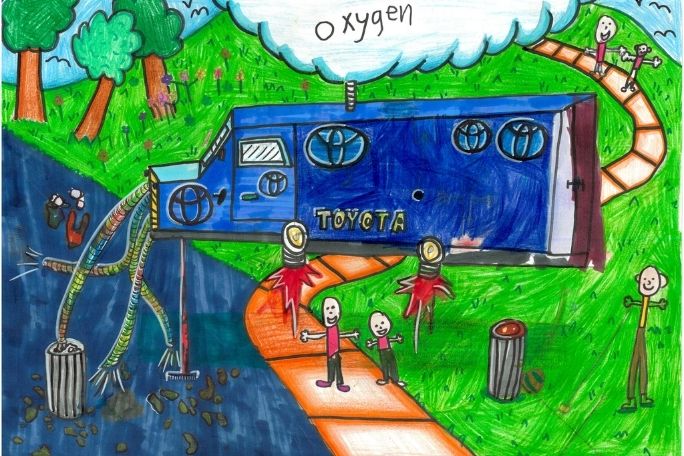Lesson summary
In this lesson, students design a dream car and create an artwork to represent their ideas that will be submitted to the Toyota Dream Car Art Contest. This contest encourages and inspires creative expression and imagination in students – some amazing ideas are born from dreams! Students explore places that are special to them and think about how they can look after their special place. They explore the different ways that places are special to people and design a dream car that can look after a place that is special to them.
Learning intentions:
Students will...
- understand that different people have different places that are special to them
- understand some of the ways we can look after special places
- understand how to communicate a message through art
- will develop and practice art-making techniques
Success criteria:
Students can...
- know why different places are special to different people
- know some of the ways we can look after special places
- plan and create artworks
- use different drawing/painting techniques
- engage in group and class discussions
Lesson guides and printables
Curriculum mapping
Australian curriculum content descriptions:
Foundation HASS:
- The reasons why some places are special to people, and how they can be looked after (ACHASSK017)
Year 1 HASS:
- The natural, managed and constructed features of places, their location, how they change and how they can be cared for (ACHASSK031)
Year 2 HASS:
- The influence of purpose, distance and accessibility on the frequency with which people visit places (ACHASSK051)
Foundation to Year 2 Visual Arts:
- Explore ideas, experiences, observations and imagination to create visual artworks and design, including considering ideas in artworks by Aboriginal and Torres Strait Islander artists (ACAVAM106)
- Use and experiment with different materials, techniques, technologies and processes to make artworks (ACAVAM107)
- Create and display artworks to communicate ideas to an audience (ACAVAM108)
Syllabus outcomes: GEe-1, GE1-1, VAS1.1, VAS1.2.
General capabilities: Critical and creative thinking.
Cross-curriculum priority: Sustainability OI.7, OI.9.
Relevant parts of Foundation HASS achievement standards: Students describe the features of familiar places and recognise why some places are special to people.
Relevant parts of Year 1 HASS achievement standards: Students recognise that people describe the features of places differently, and explain how to care for places.
Relevant parts of Year 2 HASS achievement standards: Students explain why places are important to people, recognising that places have meaning.
Relevant parts of F-2 Visual Arts achievement standards: Students make artworks in different forms to express their ideas, observations and imagination, using different techniques and processes.
Unit of work: Toyota Dream Car Art Contest.
Time required: 120 mins.
Level of teacher scaffolding: Medium – facilitate class discussion and guide students through creation of artworks.
Resources required
- Paper measuring no larger than 400mm x 550 mm (15.7-21.7in.) or A3 in size
- Scrap paper for drafting
- Drawing materials, including but not limited to: coloured pencils, pens/markers, crayons, paints, watercolour paints, etc
- A range of photos from places that students are familiar with or that they know and enjoy (e.g. home, park, beach, school, etc.)
- You could also print and use the Place Flashcards
- Previous contest winners
Skills
This lesson is designed to build students’ competencies in the following skills:
- Communication
- Creativity
- Critical thinking
- Problem Solving
Additional info
The Toyota Dream Car Art Contest usually commences late October to early November and concludes late to early March. Find up-to-date entry details, prizes and full terms and conditions here.


Welcome back!
Don't have an account yet?
Log in with:
By signing up to Cool.org you consent and agree to Cool's privacy policy to
store, manage and process your personal information. To read more, please see
our privacy policy here(Opens in new tab).
Create your free Cool.org account.
Many of our resources are free, with an option to upgrade to Cool+ for premium content.
Already have an account?
Sign up with:
By signing up to Cool.org you consent and agree to Cool's privacy policy to
store, manage and process your personal information. To read more, please see
our privacy policy here(Opens in new tab).